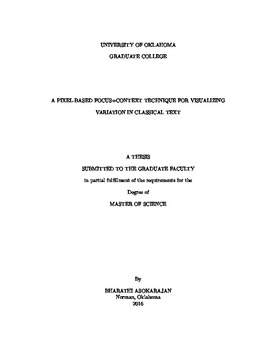| dc.description.abstract | Before the advent of printed texts, text duplication was primarily done by hand copying. As a result, numerous versions of the same text with errors, alterations, and erasures were often created. Classics scholars synthesize these multiple versions of texts to create conjectured reconstructions of the original text. Many scholars continue to use spreadsheets, and sometimes very large sheets of paper, to visually collate variations across known versions. While suitable for collection of data about variations, these approaches are generally poorly suited for analysis of variation above the level of individual words. It is hard to discern patterns of textual variation at the level of lines, pages, or entire text directly, and it requires years of training and hands-on experience to master. Scholars need tools that allow them to apply their deep expertise and express idiosyncratic queries in exploration of patterns of textual variation across scales.
This thesis contributes a novel pixel-based focus+context visualization for analyzing the historical evolution of a text. It offers interactive means to examine and characterize patterns of variation across textual scales. The technique provides a compact representation of variation data sets, allowing scholars to validate the accuracy of textual variants and identify the level of sameness between different copies and reconstructed editions of text. An overview (the context) of the entire text displays the density and distribution of features across pages. A detail view (the focus) lets scholars narrow down their analysis to points of interest, examine patterns, and assess similarities and differences. The integration of pixel-based representation and focus+context navigation allows users to explore variation across scales while preserving the continuity of experience, like one has when examining a physical manuscript. Interactive features include dynamic filtering on sources, brushing to locate variants in a traditional text layout, and details-on-demand of individual variations and their similarity measures. We conducted a usability evaluation to assess how well the technique supports common, desirable variation discovery and comparison tasks. The integrated representation and navigation style lets scholars see and compare sources above the level of words in a practical way for the first time, expanding the scope of critical analysis of essential historical texts. | en_US |
